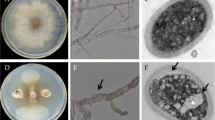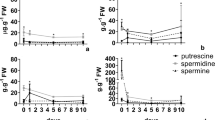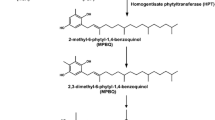Abstract
The phosphoenolpyruvate (PEP) carboxylase is regulated at the levels of transcription and post-translation in C4 plants in light and abundantly accumulates in leaf mesophyll cells. We report here developmental and photosynthetic regulation of stably accumulated Bacillus thuringiensis δ-endotoxin under the control of PEP-C promoter in transgenic sugarcane. In young leaves of plants, the transprotein is accumulated to 39% of the levels in mature leaves (135 ng mg−1), and is induced with the cell development, from base to tip. Nevertheless, these levels are decreased up to 99.98% in non-photosynthetic cells as cane matures, from top to bottom, suggesting the photosynthesis regulation of δ-endotoxin in cane cells. Further, transgenic plants are highly resistant to ‘dead heart’. In these studies, Scirpophaga nivela larvae causing ‘dead heart’ were killed within one hour of release to the transgenic plants. Therefore, this report may be regarded as the first report that provides a better strategy for developing transgenic sugarcane lines with absolute protection against invading larvae and no toxin residues in cane juice.







Similar content being viewed by others
References
Hatch MD (1987) C4 photosynthesis: a unique blend of modified biochemistry, anatomy and ultrastructure. Biochem Biophys Acta 895:81–106
Matsuoka M, Furbank R, Fukayama H, Miyao M (2001) Molecular engineering of C4 photosynthesis. Annu Rev Plant Physiol Plant Mol Biol 52:297–314
Jeanneau M, Vidal J, Gousset-Dupont A, Lebouteller B, Hodges M, Gerentes D, Perez P (2002) Manipulating PEPC levels in plants. J Exp Bot 53:1837–1845
Ku MSB, Agarie S, Nomura M, Fukayama H, Tsuchida H, Ono K, Hirose S, Toki S, Miyao M, Matsuoka M (1999) High level expression of maize phosphoenolpyruvate carboxylase in transgenic rice plants. Nat Biotechnol 17:76–80
Goatly MB, Smith H (1974) Differential properties of phosphoenolpyruvate carboxylase from etiolated and green sugar cane. Planta 117:67–73
Stockhaus J, Schlue U, Koczor M, Chitty JA, Taylor WC, Westhoff P (1997) The promoter of the gene encoding the C4 form of phosphoenolpyruvate carboxylase directs mesophyll specific expression in transgenic C4 Flaveria. Plant Cell 9:479–489
Matsuoka M, Tada Y, Fujimura T, Kano-Murakami Y (1993) Tissue-specific light-regulated expression directed by the promoter of a C4 gene, maize pyruvate, orthophosphate dikinase, in a C3 plant, rice. Proc Natl Acad Sci USA 90:9586–9590
Datta K, Vasquez Z, Tu J, Torrizo L, Alam MF, Oliva N, Abrigo E, Khush GS, Datta SK (1998) Constitutive and tissue-specific differential expression of the cryI(A)b gene in transgenic rice plants conferring resistance to rice insect pests. Theor Appl Genet 97:20–30
Offermann S, Danker T, Dreymüller D, Kalamajka R, Töpsch S, Weyand K, Peterhänsel C (2006) Illumination is necessary and sufficient to induce histone acetylation independent of transcriptional activity at the C4-specific phosphoenolpyruvate carboxylase promoter in maize. Plant Physiol 141:1078–1088
Höfte H, Whiteley HR (1989) Insecticidal crystal proteins of Bacillus thuringiensis. Microbiol Rev 53:242–255
Greenplate J (1999) Quantification of Bacillus thuringiensis insect control protein Cry1Ac over time in Bollgard cotton fruit and terminals. J Econ Entomol 92:1377–1383
Enriquez-Obregon GA, Vazquez-Padron RI, Prieto-Samsonov DL, De-la-Riva GA, Selman-Housein G (1998) Herbicide-resistant sugarcane (Saccharum officinarum L.) plants by Agrobacterium-mediated transformation. Planta 206:20–27
Gallo-Meagher M, Irvine JE (1996) Herbicide resistant transgenic sugarcane plants containing the bar gene. Crop Sci 36:1367–1374
Chowdhury MKU, Vasil KI (1992) Stably transformed herbicide resistant callus of sugarcane via microprojectile bombardment of cell suspension cultures and electroporation of protoplasts. Plant Cell Rep 11:494–498
Bower R, Elliot AR, Potier BAM, Birch RG (1996) High efficiency, microprojectile-mediated cotransformation of sugarcane, using visible or selectable markers. Mol Breed 2:239–249
Liu D, Oard SV, Oard JH (2003) High transgene expression levels in sugarcane (Saccharum officinarum L.) driven by the rice ubiquitin promoter RUBQ2. Plant Sci 165:743–750
Weng L-X, Deng H, Xu J-L, Li Q, Wang L-H, Jiang Z, Zhang HB, Li Q, Zhang L-H (2006) Regeneration of sugarcane elite breeding lines and engineering of stem borer resistance. Pest Manag Sci 62:178–187
Birch RG, Bower R, Elliot A, Potier B, Franks T, Cordeiro G (1995) Expression of foreign genes in sugarcane. In: Cock JH, Brekelbaum T (eds) Proceedings of the XXII Congress of the International Society of Sugarcane Technologists, vol 2. Tecnicana, Cali, pp 369–373
Arencibia A, Vasquez R, Prieto D, Tellez P, Carmona E, Coego A, Hernandez L, de la Riva G, Selman Housein G (1997) Transgenic sugarcane plants resistant to stem borer attack. Mol Breed 3:247–255
Rogers SO, Bendich AJ (1988) Extraction of DNA from plant tissues. Plant Mol Biol Man 6:1–10
Kota M, Daniel H, Varma S, Garczynski F, Gould F, Moar WJ (1999) Overexpression of the Bacillus thuringiensis Cry2A protein in chloroplasts confers resistance to plants against susceptible and Bt-resistant insects. Proc Natl Acad Sci USA 96:1840–1845
Christou P, Ford TL, Kofron M (1991) Production of transgenic rice (Oryza sativa) plants from agronomically important indica and japonica varieties via electric discharge particle acceleration of exogenous DNA into immature zygotic embryos. Biotechnology 9:957–962
Spencer TM, Gordon-Kamm WJ, Daines RJ, Start WG, Lemaux PG (1990) Bialaphos selection of stable transformants from maize cell culture. Theor Appl Genet 79:625–631
Vasil V, Castillo A, Fromm M, Vasil IK (1992) Herbicide resistant fertile transgenic wheat plants obtained by microprojectile bombardment of regenerable embryogenic callus. Biotechnology 10:667–674
Wan Y, Lemaux PG (1994) Generation of large numbers of independently transformed fertile barley plants. Plant Physiol 104:37–48
Cao J, Duan XL, McElroy D, Wu R (1992) Regeneration of herbicide resistant transgenic rice plants following microprojectile-mediated transformation of suspension culture cells. Plant Cell Rep 11:586–591
Toki S, Takamatsu S, Norjiri C, Ooba S, Anzai H, Iwata M, Christensen AH, Quail PH, Uchimiya H (1992) Expression of a maize ubiquitin gene promoter-bar chimeric gene in transgenic rice plants. Plant Physiol 100:1503–1507
D’Halluin K, Bonne E, Bossut M, De Beuckeleer M, Leemans J (1992) Transgenic maize plants by tissue electroporation. Plant Cell 4:1495–1505
Manickavasagam M, Gavapathi A, Anbazhagan VR, Sudhakar B, Selvaraj N, Vasudevan A, Kasthurirengan S (2004) Agrobacterium-mediated genetic transformation and development of herbicide-resistant sugarcane (Saccharum species hybrids) using axillary buds. Plant Cell Rep 23:134–143
Jabeen R, Khan MS, Zafar Y, Anjum T (2010) Codon optimization of cry1Ab gene for hyper expression in plant organelles. Mol Biol Rep 37:1011–1017
Ting IP, Osmond CB (1973) Multiple forms of plant phosphoenolpyruvate carboxylase associated with different metabolic pathways. Plant Physiol 51:448–453
Tachibana K, Watanabe T, Sekizawa T, Takematsu T (1986) Action mechanism of bialaphos II: accumulation of ammonia in plants treated with bialaphos. J Pest Sci 11:33–37
Murashige T, Skoog F (1962) A revised medium for rapid growth and bioassay with tobacco tissue culture. Physiol Plant 15:473–497
Acknowledgments
We thank Rob W. Briddon for critical reading of the manuscript. MSK is also thankful to Takashi Shiina for providing primers to perform transcript analysis. The research was funded by Ministry of Science and Technology (MoST), Islamabad to MSK. The idea was conceived by MSK and executed by MSK and SA at NIBGE; nevertheless student was registered at Punjab University with JI and MSK.
Author information
Authors and Affiliations
Corresponding author
Rights and permissions
About this article
Cite this article
Khan, M.S., Ali, S. & Iqbal, J. Developmental and photosynthetic regulation of δ-endotoxin reveals that engineered sugarcane conferring resistance to ‘dead heart’ contains no toxins in cane juice. Mol Biol Rep 38, 2359–2369 (2011). https://doi.org/10.1007/s11033-010-0369-7
Received:
Accepted:
Published:
Issue Date:
DOI: https://doi.org/10.1007/s11033-010-0369-7




